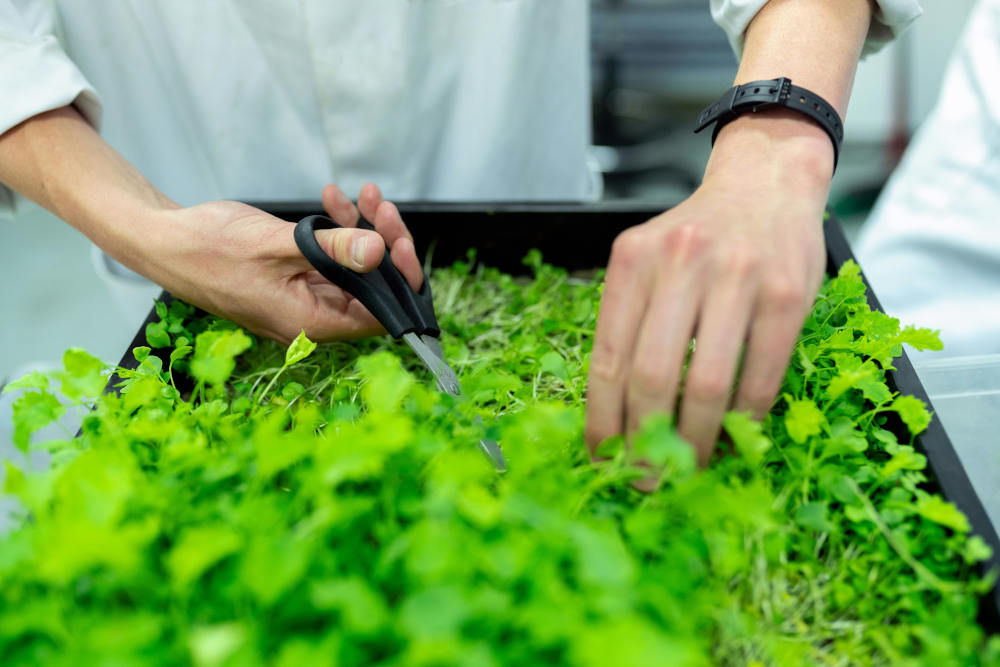
La zone 4 englobe certaines des régions les plus froides des États-Unis contigus, avec des températures hivernales minimales moyennes descendant jusqu'à -30 °F et des gelées printanières fréquentes autour du 1er juin , selon Urban Farmer ( ufseeds.com ). Cela vous offre une courte période de croissance – généralement de début juin à début octobre – qui nécessite une planification minutieuse, surtout pour le semis en intérieur.
Voici exactement quand commencer à cultiver des légumes, des herbes et des fleurs à l'intérieur, comment le planifier et comment garantir le succès, des plateaux à semis à la transplantation à l'extérieur.
Panaprium est indépendant et pris en charge par les lecteurs. Si vous achetez quelque chose via notre lien, nous pouvons gagner une commission. Si vous le pouvez, veuillez nous soutenir sur une base mensuelle. La mise en place prend moins d'une minute et vous aurez un impact important chaque mois. Merci!
1. Connaissez vos dates de gel
-
Dernières gelées : vers le 1er juin
-
Premières gelées d'automne : vers le 1er octobre ( homesteadandchill.com ).
-
Cela offre une fenêtre de culture extérieure idéale d'environ juin à septembre .
Pour démarrer des semis en intérieur, comptez à rebours à partir de votre dernier gel :
-
6 à 12 semaines avant le 1er juin = mi-mars à début avril
-
Certaines cultures nécessitent plus de temps, d’autres moins.
2. Quelles graines planter à l'intérieur et quand ?
Les délais de production varient selon les cultures. Voici une répartition basée sur les recommandations courantes :
🔹 Légumes et herbes à croissance lente (10 à 12 semaines avant le dernier gel)
-
Poireaux, oignons, céleri, persil, artichaut, choux de Bruxelles, brocoli, chou
Semis : mi-mars à début avril .
🔹 Croissance moyenne (8 à 10 semaines)
-
Poivrons, aubergines, choux-fleurs, chou vert, rutabaga, gombo
Semis : fin mars à mi-avril ( extension.umn.edu , epicgardening.com ).
🔹 Légumes de saison chaude à croissance rapide (4 à 6 semaines)
-
Tomates, chou frisé, blettes, laitue, choux, basilic
Semis : début à mi-avril ( epicgardening.com ).
🔹 Fleurs et légumes à germination rapide (2 à 4 semaines)
-
Soucis, zinnias, cosmos, concombres, courges
Semis : mi-avril à début mai .
3. Pourquoi le départ en intérieur est important en zone 4
-
Les défis des saisons courtes : les saisons de croissance peuvent durer à peine 120 jours, ce qui rend le semis direct risqué pour les cultures à longue maturation ( gardeningknowhow.com ).
-
Fenêtre de récolte prolongée : Commencer à l’intérieur aide les légumes comme les tomates ou les poivrons à mûrir correctement avant le premier gel d’automne.
4. Exemple de programme de semis en intérieur
En supposant une dernière gelée du 30 mai au 1er juin :
| Type de graine | Semaines avant le gel | Fenêtre de semis |
|---|---|---|
| Poireaux, oignons, céleri | 12 semaines | 1er au 10 mars |
| Brocoli, chou-fleur | 10 semaines | 10–20 mars |
| Basilic, poivrons, aubergines | 8 semaines | 20 mars–1er avril |
| Tomates, blettes, laitue | 6 semaines | 1er avril – 10 avril |
| Soucis, zinnias, courges | 4 semaines | 10–20 avril |
5. Semis en intérieur : bonnes pratiques
-
Utilisez un mélange de démarrage de graines de qualité : stérile, aéré et humide, non gorgé d’eau.
-
Maintenir une bonne chaleur du sol :
-
Cultures fraîches : ~65–70 °F
-
Cultures chaudes (tomate/poivron) : 21–29 °C avec un tapis chauffant ( extension.umn.edu , epicgardening.com , johnnyseeds.com , bhg.com , reddit.com ).
-
-
Fournir 12 à 16 heures de lumière par jour : les lampes de culture sont préférables pour éviter l'élongation.
-
Assurer la circulation de l’air : l’amortissement est courant, la ventilation est donc essentielle.
-
Plants clairsemés : Gardez les plus forts pour une meilleure croissance.
-
Rempotez les semis après 2 à 3 semaines pour éviter que les racines ne se bloquent.
-
Fertilisez légèrement une fois que les vraies feuilles se développent.
6. Endurcissement et repiquage
-
Commencez à endurcir les semis environ une semaine avant le repiquage : exposez-les progressivement aux conditions extérieures.
-
Transplantez après le dernier gel , avec une température du sol supérieure à 60 °F et des températures nocturnes supérieures à 50 °F.
7. Que semer directement à la place
Certaines plantes préfèrent le semis direct ou ont besoin d'une stratification à froid :
-
Petits pois, carottes, radis, betteraves, épinards, laitue
Semis direct : début mai (~1–2 semaines avant les gelées) . -
Coquelicots, pieds d'alouette, calendula : peuvent être semés directement au début du printemps ( sowtrueseed.com ).
8. Calendrier des fleurs
Périodes de semis des fleurs en intérieur :
-
Début mars : mufliers, pensées, impatiens
-
De mi-mars à début avril : soucis, calendula
-
Mi-avril : zinnias, cosmos, gloire du matin.
9. Exemple de calendrier DIY
Utilisez votre date de gel (par exemple, le 1er juin) pour créer votre emploi du temps :
-
12 semaines (10 mars) : Commencez les oignons, les poireaux et les choux
-
10 semaines (20 mars) : Début du chou-fleur et des poivrons
-
8 semaines (1er avril) : Début des tomates, des aubergines et du basilic
-
6 semaines (15 avril) : Commencer la bette à carde, la laitue et le chou frisé
-
4 semaines (25 avril) : Début des courges, des zinnias
Ce système phasé assure un flux constant de semis et évite le surpeuplement sous les lumières.
10. Conseils de dépannage
-
Des semis longilignes ? Surélevez-les ou ajoutez des lampes.
-
Fonte des semis ? Améliorez la circulation de l'air et évitez les arrosages excessifs.
-
Germination lente et faible ? Vérifiez la température du sol et la viabilité du sachet de graines.
-
Racines bloquées ? Encore une fois, transplantez plus tôt.
11. Cultures de longue saison et alternatives
Certaines cultures, comme l'artichaut, la lavande et le romarin , sont lentes ou peu fiables dans la zone 4. Il est souvent préférable d'acheter des plantes établies ou d'utiliser des boutures ( ufseeds.com , bhg.com , homesandgardens.com ).
12. Résumé
-
La courte saison de la zone 4 exige des semis en intérieur.
-
Travaillez à rebours à partir de la date de gel :
-
12 semaines pour les cultures lentes
-
8 à 10 semaines pour les cultures de saison chaude
-
4 à 6 semaines pour les plantes à croissance rapide
-
-
Utilisez des tapis chauffants, des lampes de culture et suivez les instructions du paquet de graines.
-
Endurcir avant de transplanter après le dernier gel.
-
Semez directement les cultures rustiques au début du printemps.
Réflexions finales et planification ultérieure
En suivant un calendrier structuré et en accordant une attention particulière à la date de votre dernier gel, vous pouvez maximiser votre saison de croissance , profiter de meilleures récoltes et utiliser votre espace efficacement.
Cet article vous a-t-il été utile ? S'il vous plaît dites-nous ce que vous avez aimé ou n'avez pas aimé dans les commentaires ci-dessous.
About the Author: Alex Assoune
Contre Quoi Nous Luttons
Les groupes multinationaux surproduisent des produits bon marché dans les pays les plus pauvres.
Des usines de production où les conditions s’apparentent à celles d’ateliers clandestins et qui sous-payent les travailleurs.
Des conglomérats médiatiques faisant la promotion de produits non éthiques et non durables.
De mauvais acteurs encourageant la surconsommation par un comportement inconscient.
- - - -
Heureusement, nous avons nos supporters, dont vous.
Panaprium est financé par des lecteurs comme vous qui souhaitent nous rejoindre dans notre mission visant à rendre le monde entièrement respectueux de l'environnement.
Si vous le pouvez, veuillez nous soutenir sur une base mensuelle. Cela prend moins d'une minute et vous aurez un impact important chaque mois. Merci.































0 commentaire